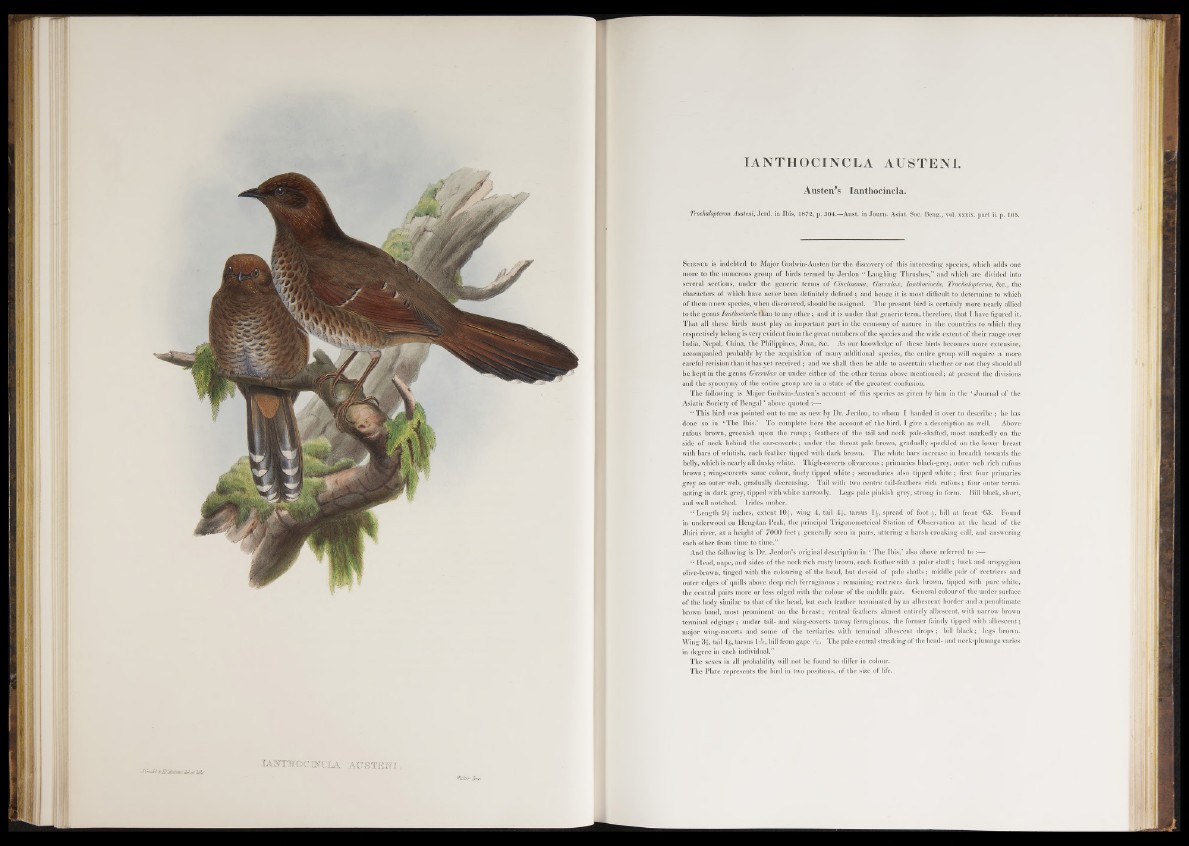
Austen’s Ianthocincla.
Trochalopteron Austeni, Jercl. in Ibis, 1872, p. 304.—Aust. in Journ. Asiat. Soc. Beng., vol. xxxix. part ii. p. 105.
S c ien c e is indebted to Major Godwin-Austen for the discovery o f this interesting species, which adds one
more to the numerous group of birds termed by Jerdon “ Laughing Thrushes,” and which are divided into
several sections, under the generic terms of Cinclosoma, Garrulaa?, Ianthocincla, Trochalopteron, &c., the
characters of which have never been definitely defined ; and hence it is most difficult to determine to which
o f them a new species, when discovered, should be assigned. The present bird is certainly more nearly allied
to the genus Ianthocincla than to any o th er; and it is under that generic term, therefore, that I have figured it.
That all these birds must play an important part in the economy o f nature in the countries to which they
respectively belong is very evident from the great numbers of the species and the wide extent of their range over
India, Nepal, China, the Philippines, Java, &c. As our knowledge of these birds becomes more extensive,
accompanied probably by the acquisition of many additional species, the entire group will require a more
careful revision than it has yet received; and we shall then be able to ascertain whether or not they should all
be kept in the genus Garrulaco or under either of the other terms above mentioned; at present the divisions
and the synonymy o f the entire group are in a state of the greatest confusion.
The following is Major Godwin-Austen’s account of this species as given by him in the ‘ Journal of the
Asiatic Society o f Bengal ’ above quoted :|=|ÍBH3
“ This bird was pointed out to me as new by Dr. Jerdon, to whom I handed it over to describe ; he has
done so in ‘ The Ibis.’ To complete here the account of the bird, I give a description as well. Above
rufous brown, greenish upon the rum p ; feathers of the tail and neck pale-shafted, most markedly on the
side of neck behind the ear-coverts; under the throat pale brown, gradually speckled on the lower breast
with bars of whitish, each feather tipped with dark brown. The white bars increase in breadth towards the
belly, which is nearly all dusky white. Thigh-coverts olivaceous; primaries black-grey, outer web rich rufous
brown; wing-coverts same colour, finely tipped white ; secondaries also tipped white ; first four primaries
grey on outer web, gradually decreasing. Tail with two centre tail-feathers rich rufous; four outer terminating
in dark grey, tipped with white narrowly. Legs pale pinkish grey, strong in form. Bill black, short,
and well notched. Irides umber.
“ Length 9£ inches, extent 10i, wing 4, tail 44-, tarsus l£, spread of foot a, bill a t front -63. Found
in underwood on Hengdan Peak, the principal Trigonometrical Station of Observation a t the head of the
Jh iri river, at a height of 7000 fe e t; generally seen in pairs, uttering a harsh croaking call, and answering
each other from time to time.”
And the following is Dr. Jerdon’s original description in ‘ The Ibis,’ also above referred to ■
“ Head, nape, and sides of the neck rich rusty brown, each feather with a paler sh a ft; back and uropygium
olive-brown, tinged with the colouring of the head, but devoid of pale shafts; middle pair of rectrices and
outer edges o f quills above deep rich ferruginous ; remaining rectrices dark brown, tipped with pure white,
the central pairs more or less edged with the colour of the middle pair. General colour o f the under surface
of the body similar to that of the head, but each feather terminated by an albescent border and a penultimate
brown band, most prominent on the breast; ventral feathers almost entirely albescent, with narrow brown
terminal edgings ; under tail- and wing-coverts tawny ferruginous, the former faintly tipped with albescent;
major wing-coverts and some of the tertiaries with terminal albescent d ro p s; bill black; legs brown.
Wing 3$, tail 4x, tarsus 1 A, bill from gape tV- The pale central streaking of the head- and neck-plumage varies
in degree in each individual.”
The sexes in all probability will not be found to differ in colour.
The Plate represents the bird in two positions, of the size of life.